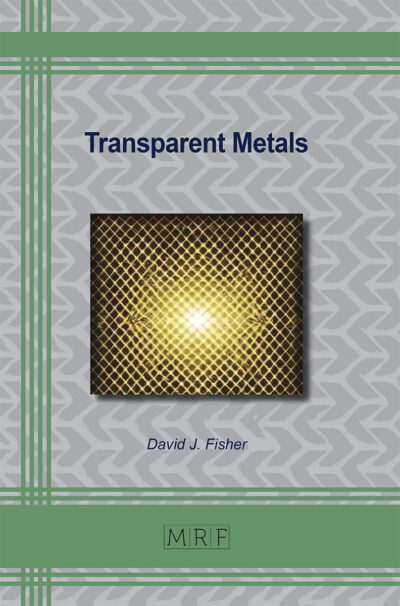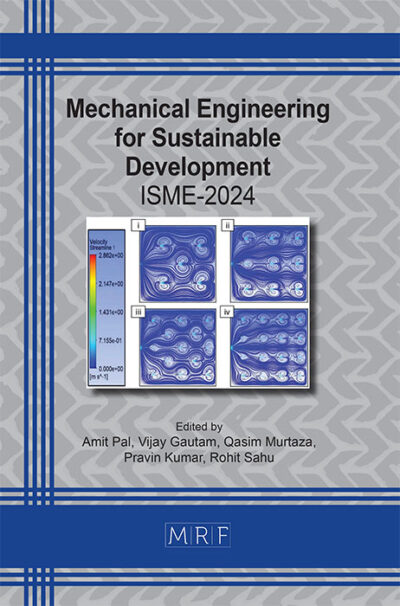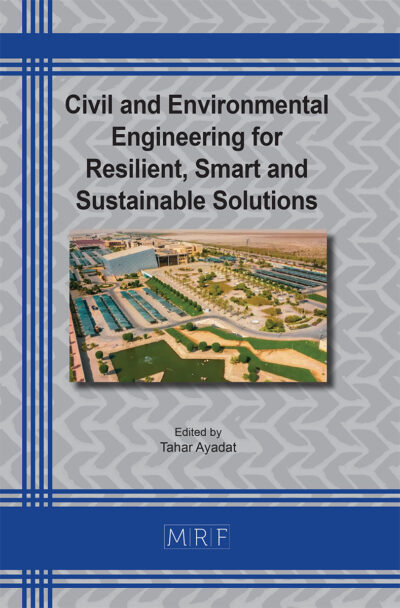Response surface methodology (RSM) for predicting and optimizing the pressure drop in submerged multi-jet electrolyte flow system
Yara Sami H ALGHANNAM, Lujain Abdullah A ALTEWAIRQI, Feroz SHAIK, Faizan AHMED, Nayeemuddin MOHAMMED, Ratna Sunil BURADAGUNTA
Abstract. Submerged multi-jet electrolyte flow systems require efficient design and operation to support a variety of industrial operations, including electrochemical machining and electroplating. In this work, we give a thorough analysis of the optimization and prediction of pressure drop in such systems through the use of Response Surface Methodology (RSM). First, under various operating conditions, experimental data are gathered from a prototype submerged multi-jet electrolyte flow configuration. Further, empirical models illustrating the connection between process factors and pressure drop are produced using the Response Surface Methodology. There is less than 0.2 discrepancy between the adjusted R² of 0.9988 and the expected R² of 0.9986, indicating a fair agreement in the pressure drop measurement. In submerged multi-jet electrolyte flow systems, the suggested methodology provides a methodical and effective way to forecast and optimize pressure drop. This allows for improved process performance and efficiency in industrial applications.
Keywords
Response Surface Methodology, Multi Jet Electrolyte Flow, Pressure Drop, ANNOVA, Optimization
Published online 2/25/2025, 10 pages
Copyright © 2025 by the author(s)
Published under license by Materials Research Forum LLC., Millersville PA, USA
Citation: Yara Sami H ALGHANNAM, Lujain Abdullah A ALTEWAIRQI, Feroz SHAIK, Faizan AHMED, Nayeemuddin MOHAMMED, Ratna Sunil BURADAGUNTA, Response surface methodology (RSM) for predicting and optimizing the pressure drop in submerged multi-jet electrolyte flow system, Materials Research Proceedings, Vol. 48, pp 697-706, 2025
DOI: https://doi.org/10.21741/9781644903414-76
The article was published as article 76 of the book Civil and Environmental Engineering for Resilient, Smart and Sustainable Solutions
![]() Content from this work may be used under the terms of the Creative Commons Attribution 3.0 license. Any further distribution of this work must maintain attribution to the author(s) and the title of the work, journal citation and DOI.
Content from this work may be used under the terms of the Creative Commons Attribution 3.0 license. Any further distribution of this work must maintain attribution to the author(s) and the title of the work, journal citation and DOI.
References
[1] Rao, G. A., Kitron-Belinkov, M., & Levy, Y. (2009). Numerical analysis of a multiple jet impingement system. In Turbo Expo: Power for Land, Sea, and Air, Vol. 48845, pp. 629-639. https://doi.org/10.1115/GT2009-59719
[2] Levy, Y., Rao, A. G., Erenburg, V., Sherbaum, V., Gaissinski, I., & Krapp, V. (2012). Pressure losses for jet array impingement with crossflow. In Turbo Expo: Power for Land, Sea, and Air, American Society of Mechanical Engineers, Vol. 44700, pp. 139-149. https://doi.org/10.1115/GT2012-68386
[3] Miran, S., Hussain, M. I., Jauhar, T. A., Kiren, T., Arif, W., & Lee, G. H. (2024). Modeling and optimization of impinging jet pressure using artificial intelligence. Alexandria Engineering Journal, Vol. 87, pp. 489-500. https://doi.org/10.1016/j.aej.2023.12.048
[4] Arabnejad, H., Mansouri, A., Shirazi, S. A., & McLaury, B. S. (2016). CFD Simulation of Round Impinging Jet and Comparison with Experimental Data. In Fluids Engineering Division Summer Meeting, American Society of Mechanical Engineers, Vol. 50282, pp. V01AT06A004. https://doi.org/10.1115/FEDSM2016-7889
[5] Rundstrom, D., & Moshfegh, B. (2007). RSM and v2-f study on the flow behavior of an impinging jet in a cross-flow on a wall-mounted cube. Progress in Computational Fluid Dynamics, An International Journal, 7(6), 311-322. https://doi.org/10.1504/PCFD.2007.014681
[6] Ahmed, F., Aziz, M. S. A., Shaik, F., & Khor, C. Y. (2024). Salinity impacts on a unique desalination system embedded with concentrated solar energy for cleaner production. Journal of Cleaner Production, 434, 140223. https://doi.org/10.1016/j.jclepro.2023.140223
[7] Ahmed, F., Aziz, M. S. A., Shaik, F., & Khor, C. Y. (2024). Performance assessment of a unique solar desalination device operating with concentrating solar power technology and variable feed temperatures. Chemical Engineering and Processing-Process Intensification, 109722. https://doi.org/10.1016/j.cep.2024.109722
[8] Ahmed, F., Aziz, M. S. A., Palaniandy, P., & Shaik, F. (2022). A review on application of renewable energy for desalination technologies with emphasis on concentrated solar power. Sustainable Energy Technologies and Assessments, 53, 102772. https://doi.org/10.1016/j.seta.2022.102772
[9] Ahmed, F., Abdul Aziz, M. S., Mohd Arif Zainol, M. R. R., Yee, K. C., Shaik, F., Che Halin, D. S, & Kheimi, M. (2022). Design, modelling and optimization of a novel concentrated solar powered (CSP) flash desalination system involving direct heating and pressure modulation using response surface methodology (RSM). Sustainability, 14(18), 11558. https://doi.org/10.3390/su141811558
[10] Ahmed, F., Aziz, M. S. A., Shaik, F., & Khor, C. Y. (2023). Optimization of a novel spray flash desalination system integrated with concentrated solar power utilizing response surface methodology. Desalination, 558, 116640. https://doi.org/10.1016/j.desal.2023.116640
[11] Feroz, S, Prasad, V. (2006). Mass Transfer Coefficients at the Stagnation Point with Submerged Impinging Multi-Jet Flow of Fluid Electrolyte. Turkish J. Eng. Env. Sci, 30, 1-9.
[12] Mohammed Nayeemuddin, Palaniandy Puganeshwary, Shaik Feroz, Optimization of solar photocatalytic biodegradability of seawater using statistical modelling, Journal of Indian Chemical Society, 98 (2021) 100240; https://doi.org/10.1016/j.jics.2021.100240
[13] Mohammed Nayeemuddin, Palaniandy Puganeshwary, Shaik Feroz, Solar photocatalytic biodegradability of saline water: Optimization using RSM and ANN, AIP Conference Proceedings, 2463 (2022) 020027; https://doi.org/10.1063/5.0080297
[14] Manappallil Joy Varghese, Shaik Feroz, Susmita Dutta, Artificial intelligence-based multiobjective optimization of reverse osmosis desalination pretreatment using a hybrid ZnO-immobilized/photo-Fenton process, Chemometrics, 3434 (2022) 1-16; https://doi.org10.1002/cem.3434
[15] Nayeemuddin Mohammed, Puganeshwary Palaniandy, Feroz Shaik, Balakrishnan Deepanraj, Hiren Mewada, Statistical analysis by using soft computing methods for seawater biodegradability using ZnO photocatalyst, Environmental Research 227 (2023) 115696; https://doi.org/10.1016/j.envres.2023.115696
[16] Nayeemuddin Mohammed, Puganeshwary Palaniandy, Feroz Shaik, Hiren Mewada, Statistical modelling of solar photocatalytic biodegradability of seawater using combined photocatalysts, J. Inst. Eng. India Ser E, 2023; https://doi.org/10.1007/s40034-023-00274-8
[17] Nayeemuddin Mohammed, Puganeshwary Palaniandy, Feroz Shaik, Hiren Mewada, Experimental and computational analysis for optimization of seawater biodegradability using photocatalysis, IIUM Engineering Journal, 24(2) 2023, 11-33; https://doi.org/10.31436/iiumej.v24i2.2650
[18] Y. Eroğlu and S. U. Seçkiner, “Wind farm layout optimization using particle filtering approach,” Renewable Energy, vol. 58, pp. 95–107, Oct. 2013. https://doi.org/10.1016/j.renene.2013.02.019
[19] N. O. Farrar, M. H. Ali, and D. Dasgupta, “Artificial Intelligence and Machine Learning in Grid Connected Wind Turbine Control Systems: A Comprehensive Review,” Energies, vol. 16, no. 3, p. 1530, Feb. 2023. https://doi.org/10.3390/en16031530
[20] F. Elyasichamazkoti and A. Khajehpoor, “Application of machine learning for wind energy from design to energy-Water nexus: A Survey,” Energy Nexus, vol. 2, p. 100011, Dec. 2021. https://doi.org/10.1016/j.nexus.2021.100011
[21] N. Mohammed, P. Palaniandy, and F. Shaik, “Pollutants removal from saline water by solar photocatalysis: a review of experimental and theoretical approaches,” International Journal of Environmental Analytical Chemistry, vol. 103, no. 16, pp. 4155–4175, Dec. 2023. https://doi.org/10.1080/03067319.2021.1924160
[22] N. Mohammed, A. Asiz, M. A. Khasawneh, H. Mewada, and T. Sultana, “Machine learning and RSM-CCD analysis of green concrete made from waste water plastic bottle caps: Towards performance and optimization,” Mechanics of Advanced Materials and Structures, pp. 1–9, Aug. 2023. https://doi.org/10.1080/15376494.2023.2238220
[23] N. Mohammed, P. Palaniandy, F. Shaik, H. Mewada, and D. Balakrishnan, “Comparative studies of RSM Box-Behnken and ANN-Anfis fuzzy statistical analysis for seawater biodegradability using TiO2 photocatalyst,” Chemosphere, vol. 314, p. 137665, Feb. 2023. https://doi.org/10.1016/j.chemosphere.2022.137665
“”












